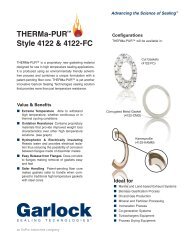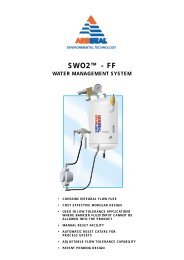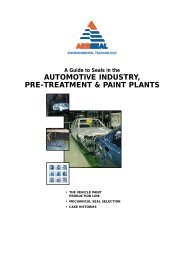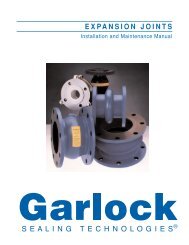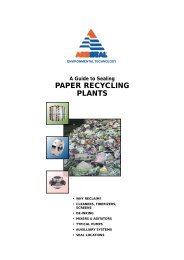You also want an ePaper? Increase the reach of your titles
YUMPU automatically turns print PDFs into web optimized ePapers that Google loves.
<strong>Cam</strong>-Tite Ball Valve Operating Instructions<br />
Warning<br />
ITT Industries valves and valve actuators are designed and manufactured using good workmanship and materials,<br />
and they meet all applicable industry standards. These valves are available with components of various materials, and<br />
they should be used only in services recommended in our product catalog or by a company valve engineer.<br />
Misapplication of the product may result in injuries or property damage. A selection of valve components of the<br />
proper materials consistent with the particular performance requirements is important for proper application. Examples<br />
of the misapplication or misuse of ITT Industries products include use in an application in which the<br />
pressure/temperature rating is exceeded or failure to maintain the valve as recommended.<br />
If the valve exhibits any indication of leakage, do not operate. Isolate the valve and either repair or replace it.<br />
Installation/Operating Instructions<br />
1. This valve can be installed in any position consistent with good piping practice.<br />
2. If this valve has been furnished with a means for relieving body cavity pressure (i.e. a cavity vent), an arrow on the<br />
exterior of the valve indicates the direction of pressure tightness. Note: Vented valves are unidirectional.<br />
3. Prior to installation, inspect valve for shipping damage.<br />
4. If this valve is weld end, it may be welded into the pipeline without disassembly provided certain procedures and<br />
precautions are taken. The valve should be in the "open" position during welding and should remain open until it<br />
cools to ambient temperature. Welding procedures in accordance with Section IX of the ASME Boiler and Pressure<br />
Vessel Code should be utilized. In addition, a 350°F Tempilstik (for PTFE and RTFE seats and seals) or a 200°F<br />
Tempilstik (for UHMWP seats and seals) must be used to monitor the temperature of the seat/gasket area. Page<br />
12 shows the location on the valve body where the Tempilstik marks should be placed. This is the area in line with<br />
the body/cover flange. Welding should be controlled to maintain this area below 350°F or 200°F as noted above.<br />
If valves are furnished with other than PTFE, RTFE, or UHMWP seats/seals, contact the factory for recommended<br />
welding procedures. (See Page 12 of this brochure for additional details.)<br />
5. Prior to installation or system pressurization, tighten the stem seal nut in accordance with the torques listed in<br />
Chart #1. CAUTION: Do not back off stem seal nut while the valve is pressurized.<br />
6. Install the operating handle on the valve stem. Insure that the handle is sitting flush with the top of the packing nut<br />
and that the handle posts ( 1 /2"–2") are aligned with the groove pin travel stop to assure proper rotation of the<br />
handle. Tighten hex jam nut and handle screw ( 1 /2"–2" sizes) or tighten handle screw only (3"–6" sizes).<br />
7. Prior to installation or system pressurization, evenly tighten all cover bolting using the cross-cross method in<br />
accordance with the torques listed in Chart #2. CAUTION: Do not loosen cover bolts while the valve is<br />
pressurized.<br />
8. If necessary, repeat steps 5, 6, and 7 approximately 24 hours after system reaches operating temperature and<br />
pressure.<br />
9. Refer to the exploded view on page 41 of this brochure for proper parts identification. Always utilize factory<br />
authorized replacement parts.<br />
10. Good operating procedure requires periodic inspection of valves and replacement of necessary parts to ensure<br />
proper valve function.<br />
11. NOTE: Valves showing through leakage or high operating torque may be damaged. DO NOT use excessive force<br />
or cheater bars to operate valve. Disassemble valve, inspect components, and replace damaged parts.<br />
CAUTION: Before attempting removal/repair, always cycle valve with system pressure isolated to relieve<br />
excess pressure which may be trapped in body cavity.<br />
Maintenance Instructions — Cover Gasket Repair<br />
1. Periodically inspect condition of external valve components. Replace all parts showing excessive wear or corrosion.<br />
2. If cover gasket leaks, immediately tighten cover bolting as described under Installation Instructions, Item 7. If<br />
tightening cover bolting does not stop leak, remove pressure from valve and place valve in open position.<br />
3. Remove cover bolting and lift cover assembly off of valve body.<br />
4. Carefully remove cover gasket from body recess or from cover.<br />
38



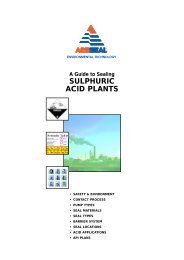
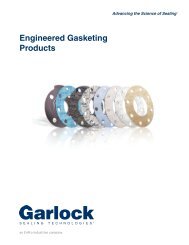
![VCS Flange Gasket [1.03 MB] - AR Thomson Group](https://img.yumpu.com/12044617/1/190x245/vcs-flange-gasket-103-mb-ar-thomson-group.jpg?quality=85)

![PGE Flange Gasket Product Brochure [1.04 MB] - AR Thomson Group](https://img.yumpu.com/12044595/1/190x245/pge-flange-gasket-product-brochure-104-mb-ar-thomson-group.jpg?quality=85)
